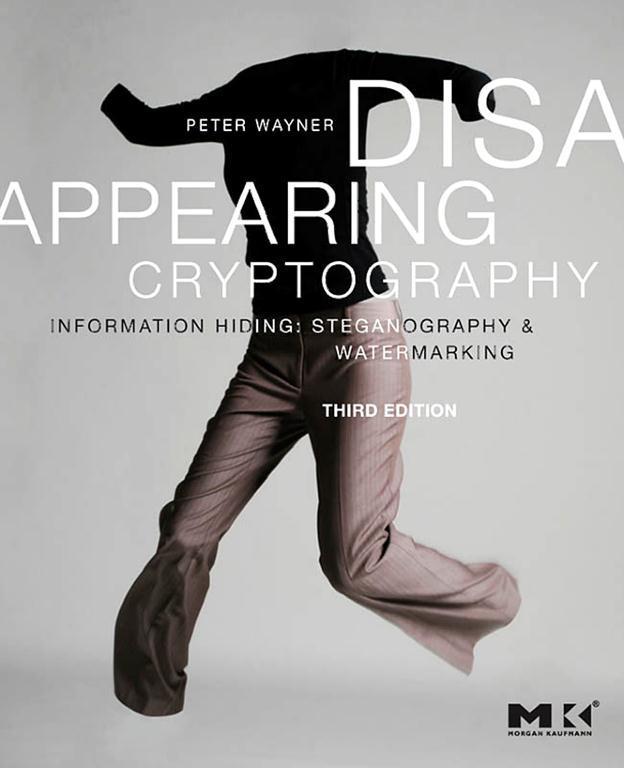Cryptology is the practice of hiding digital information by means of various obfuscatory and steganographic techniques. The application of said techniques facilitates message confidentiality and sender/receiver identity authentication, and helps to ensure the integrity and security of computer passwords, ATM card information, digital signatures, DVD and HDDVD content, and electronic commerce. Cryptography is also central to digital rights management (DRM), a group of techniques for technologically controlling the use of copyrighted material that is being widely implemented and deployed at the behest of corporations that own and create revenue from the hundreds of thousands of mini-transactions that take place daily on programs like iTunes.
This new edition of our best-selling book on cryptography and information hiding delineates a number of different methods to hide information in all types of digital media files. These methods include encryption, compression, data embedding and watermarking, data mimicry, and scrambling. During the last 5 years, the continued advancement and exponential increase of computer processing power have enhanced the efficacy and scope of electronic espionage and content appropriation. Therefore, this edition has amended and expanded outdated sections in accordance with new dangers, and includes 5 completely new chapters that introduce newer more sophisticated and refined cryptographic algorithms and techniques (such as fingerprinting, synchronization, and quantization) capable of withstanding the evolved forms of attack.
Each chapter is divided into sections, first providing an introduction and high-level summary for those who wish to understand the concepts without wading through technical explanations, and then presenting concrete examples and greater detail for those who want to write their own programs. This combination of practicality and theory allows programmers and system designers to not only implement tried and true encryption procedures, but also consider probable future developments in their designs, thus fulfilling the need for preemptive caution that is becoming ever more explicit as the transference of digital media escalates.
- Includes 5 completely new chapters that delineate the most current and sophisticated cryptographic algorithms, allowing readers to protect their information against even the most evolved electronic attacks
- Conceptual tutelage in conjunction with detailed mathematical directives allows the reader to not only understand encryption procedures, but also to write programs which anticipate future security developments in their design
Inhaltsverzeichnis
1;Front Cover;1 2;Disappearing Cryptography: Information Hiding: Steganography & Watermarking;2 3;Copyright Page;3 4;Contents;4 5;About the Author;12 6;Preface;14 7;Book Notes;16 7.1;0.1 Notes On the Third Edition;19 7.2;0.2 Notes On the Second Edition;20 8;Chapter 1 Framing Information;22 8.1;1.1 Adding Context;33 9;Chapter 2 Encryption;36 9.1;2.1 Pure White;36 9.2;2.2 Encryption and White Noise;37 9.3;2.3 Measuring and Encrypting Information;48 9.4;2.4 Summary;52 10;Chapter 3 Error Correction;54 10.1;3.1 Close but No Cigar;54 10.2;3.2 Correcting Errors;54 10.3;3.3 Constructing Error-Correcting Codes;63 10.4;3.4 Summary;68 11;Chapter 4 Secret Sharing;72 11.1;4.1 Two out of Three Musketeers;72 11.2;4.2 Splitting Up Secrets;73 11.3;4.3 Building Secret-Sharing Schemes;80 11.4;4.4 Public-Key Secret Sharing;83 11.5;4.5 Steganographic File Systems and Secret Sharing;84 11.6;4.6 Summary;88 12;Chapter 5 Compression;90 12.1;5.1 Television Listing;90 12.2;5.2 Patterns and Compression;91 12.3;5.3 Building Compression Algorithms;96 12.4;5.4 Summary;102 13;Chapter 6 Basic Mimicry;104 13.1;6.1 Reading between the Lines;104 13.2;6.2 Running in Reverse;105 13.3;6.3 Implementing the Mimicry;111 13.4;6.4 Summary;117 14;Chapter 7 Grammars and Mimicry;120 14.1;7.1 Evolution of Everyday Things;120 14.2;7.2 Using Grammar for Mimicry;122 14.3;7.3 Creating Grammar-Based Mimicry;131 14.4;7.4 Summary;149 15;Chapter 8 Turing and Reverse;154 15.1;8.1 Doggies Little Get Along;154 15.2;8.2 Running Backward;155 15.3;8.3 Building a Reversible Machine;164 15.4;8.4 Summary;172 16;Chapter 9 Life in the Noise;174 16.1;9.1 Boy-Zs in Noizy, Idaho;174 16.2;9.2 Hiding in the Noise;176 16.3;9.3 Bit Twiddling;187 16.4;9.4 Random Walks and Subsets;195 16.5;9.5 Putting JPEG to Use;200 16.6;9.6 Summary;208 17;Chapter 10 Anonymous Remailers;210 17.1;10.1 Dr. Anon to You;210 17.2;10.2 Anonymous Remailers;212 17.3;10.3 Remailer Guts;217 17.4;10.4 Anonymous Networks;224 17.5;10.5 Long term storage;229 17.6;10.6 P
ublius;232 17.7;10.7 Onion Routing;234 17.8;10.8 Anonymous Auction Protocols;244 17.9;10.9 The Future;245 17.10;10.10 Summary;246 18;Chapter 11 Secret Broadcasts;248 18.1;11.1 Table Talk;248 18.2;11.2 Secret Senders;248 18.3;11.3 Creating a DC Net;252 18.4;11.4 Summary;255 19;Chapter 12 Keys;258 19.1;12.1 The Key Vision;258 19.2;12.2 Extending Control;259 19.3;12.3 Signing Algorithms;261 19.4;12.4 Public-Key Algorithms;262 19.5;12.5 Zero Knowledge Approaches;269 19.6;12.6 Collusion Control;275 19.7;12.7 Summary;276 20;Chapter 13 Ordering and Reordering;278 20.1;13.1 Top 10 Reasons Why Top 10 Lists Fail;278 20.2;13.2 Introduction;279 20.3;13.3 Strength Against Scrambling;280 20.4;13.4 Invariant Forms;282 20.5;13.5 Canonical Forms;282 20.6;13.6 Packing in Multiple Messages;283 20.7;13.7 Sorting to Hide Information;284 20.8;13.8 Word Scrambling;286 20.9;13.9 Adding Extra Packets;287 20.10;13.10 Port Knocking;288 20.11;13.11 Continuous Use and Jamming;291 20.12;13.12 Summary;292 21;Chapter 14 Spreading;294 21.1;14.1 A New Job;294 21.2;14.2 Spreading the Information;296 21.3;14.3 Going Digital;300 21.4;14.4 Comparative Blocks;307 21.5;14.5 Fast Fourier Solutions;311 21.6;14.6 The Fast Fourier Transform;314 21.7;14.7 Hiding Information with FFTs and DCTs;316 21.8;14.8 Wavelets;324 21.9;14.9 Modifications;326 21.10;14.10 Summary;328 22;Chapter 15 Synthetic Worlds;330 22.1;15.1 Slam Dunks;330 22.2;15.2 Created Worlds;331 22.3;15.3 Text Position Encoding and OCR;333 22.4;15.4 Echo Hiding;337 22.5;15.5 Summary;338 23;Chapter 16 Watermarks;340 23.1;16.1 A Patent for Watermarking Humans;340 23.2;16.2 Tagging Digital Documents;341 23.3;16.4 An Averaging Watermark;348 23.4;16.5 Summary;352 24;Chapter 17 Steganalysis;354 24.1;17.1 Code Words;354 24.2;17.2 Finding Hidden Messages;354 24.3;17.3 Typical Approaches;356 24.4;17.4 Visual and Aural Attacks;357 24.5;17.5 Structural Attacks;361 24.6;17.6 Statistical Attacks;365 24.7;17.7 Summary;368 25;Chapter 18 Obfuscation;372 25.1;18.1
Regulation;372 25.2;18.2 Code Rearrangement;373 25.3;18.3 Compiling Intelligence;374 25.4;18.4 Real Tools;379 25.5;18.5 Summary;380 26;Chapter 19 Synchronization;382 26.1;19.1 Stealing Baseballs Signs;382 26.2;19.2 Getting In Sync;383 26.3;19.3 Extending Other Tools;384 26.4;19.4 Summary;387 27;Chapter 20 Translucent Databases;390 27.1;20.1 Missed Connections;390 27.2;20.2 Hiding In Databases;390 27.3;20.3 Using Strong One-Way Functions;393 27.4;20.4 Summary;394 28;Chapter 21 Plain Sight;396 28.1;21.1 Laughtracks;396 28.2;21.2 Hiding in the Open;397 28.3;21.3 Other Formats;398 28.4;21.4 Summary;402 29;Chapter 22 Coda;404 30;A Software;408 30.1;A.1 Commercial Packages;408 30.2;A.2 Open Packages;409 30.3;A.3 Steganalysis Software;414 31;Bibliographic Notes;416 32;Bibliography;420 33;Index;448
